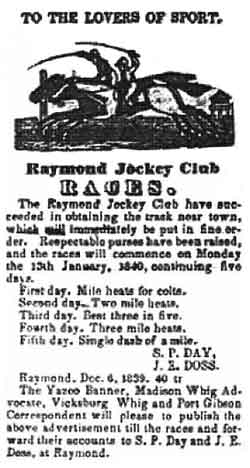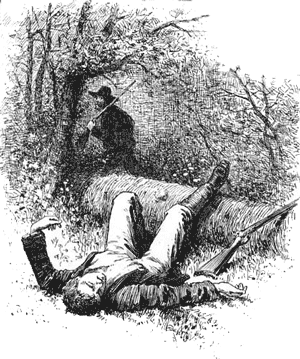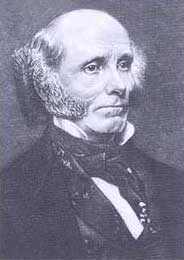"Raymond Years Ago"
By George W. Harper
Journalist - Editor - Owner Of Hinds County Gazette 1845-1883
A Series Published in the Hinds County Gazette, 1878-1879
From the Gillespie Collections edited by Pattie Adams Snowball and Rebecca Blackwell Drake
Home Page
Harper Arrives in Mississippi
Vicksburg & Meridian RR
Businesses in 1844
The Raymond Bar
Early Merchants
1844 Businesses
Seat of Justice
Cotton Industry
Early Churches
Establishment of Schools
John B. Peyton
Raymond Area Homes
Medicinal Resorts & Spas
The Mexican War
Early Churches
Early Schools
Raymond Female Institute
Raymond Military Institute
McNutt-Foote Debate
1844 Presidential Election
Local Elections of 1845
Literary Raymond
Raymond Fires
Old Log Jail
Death of Jos. Stewart
Murder of Benj. Sims
Duel Ends in Death
Raymond & Bolton RR
Harper Elected Mayor
Chaos at Oak Tree Hotel
Great Fire of 1858
Early Area Settlements
-
Amsterdam
-
Yeizer's Store
-
Newtown
-
Meridian Springs
-
Sturgiss Store
-
Dry Grove
-
County Line
Rev. Fisk's Biology Class
Fisk Charged with Fraud
Fleetwood Tragedy
Local Racetracks
Dignitaries Visit Raymond
Winning the Lottery
Fire Company No. 1
"Devoted & Valued Friend"
Tribute to Amos Johnson
Yellow Fever Strikes Raymond
Doctors Treating Victims
Cooper's Well
Mississippi Springs
Newspaper Entrepreneurs
Yankees Sack Gazette Office
Fate of Editorial Giants
Henry Clay Defeated in 1844
Stray Cats in Raymond
"A Remarkable Occurrence"
Blow That Punky Bell to Hell"
Isom Bldgs Destroyed
1851 Gubernatorial Election
Union Ticket Sweeps State
New Raymond Courthouse
Gibbs Building Rebuilt
Hinds Co. Poor House
Schools Struggle
Murder of Addie Owens
War comes to Raymond
The Battle of Raymond
Willie Foote Captured
Make-shift Hospitals
Yankees Occupy Raymond
Raymond Lodge No. 21
Odd-Fellows' Graveyard
Bolls Incarceration
Crimes Blamed on Whisky
Peyton's Willow Tree Prank
Politics in Raymond
Presidential Election 1860
Hinds Co. for Succession
Raymond Fencibles Organized
Churches Reorganize
The Clinton Riot of 1875
Why the Great Uneasiness?
Deaths of Sivley & Thomson
"Kill the Raymond Men"
Harrison Election
Political Gatherings
Event at Dupree's Grove
Presidential Election 1876
Governor Ames Impeached
Great Wrongs Investigated
Fight the Devil with Fire
Reconstruction Era
Harper Ends with Poetic Vision
Part VI
The Death of Jos. W. Stewart
One of the saddest and most deeply lamented accidents that
every occurred in Raymond, happened in 1846. It was then the custom of the young
men of the town, (and in some instances the old men, too,) to meet in the
afternoon about where the steam gin now stands and make up horse races for
amusement from the stock of the town and neighborhood, the track being the
public road from the point designated to Snake creek bridge.
 Large numbers of
the citizens would collect at this point every afternoon - and especially on the
afternoon of Saturday - when races would be made up in which great interest was
sometimes exhibited. John Gallman lived in the town at that time, and happened
to get hold of a common looking horse, which, however, succeeded in beating
every other horse in the town and neighborhood.
Large numbers of
the citizens would collect at this point every afternoon - and especially on the
afternoon of Saturday - when races would be made up in which great interest was
sometimes exhibited. John Gallman lived in the town at that time, and happened
to get hold of a common looking horse, which, however, succeeded in beating
every other horse in the town and neighborhood.
Jos. W. Stewart, who was then probate clerk, and one of the most beloved men of the county, had had his favorite saddle horse beaten by Gallman’s imported animal, and determined to introduce a new horse, but before doing so concluded to try his speed on the track with another horse, owned by W. S. Belcher. And, for this purpose, Mr. Stewart and Mr. Belcher, very early one pleasant morning, repaired to Snake creek bridge, and from there started, each on his horse. Soon after starting Mr. Stewart’s horse broke from his control, and rushing wildly off to the left hand, among the buses and trees, dashed Mr. Stewart’s head against a tree. He fell from his horse dead - his neck was broken. We never knew a better man than Jos. W. Stewart, and in his death the entire community deeply sympathized. He was followed to the grave by the Masons and Odd-Fellows, and a very large concourse of people and heartfelt were the lamentations throughout the county. And, this sad and most melancholy occurrence closed the racing on the track described.
The Murder of Benj. G. Sims
One of the most thrilling scenes that we ever witnessed in a court of justice, took place in the old courthouse in Raymond. In 1846, and exposed the perpetrators of one of the most brutal murders in the annals of crime in this county. Benj. G. Sims was a highly intelligent and substantial planter, living on the place three miles from town, now owned by H. D. Austin. He opened up that place in 1839 and ’40 - built the residence gin, &c, and off to the south of the residence put up a steam saw mill.
 In 1846 he had an
overseer named Fontaine Silas, and a manager at the mill named Keithler, a
Canadian. Silas was a very weak and illiterate man, but Keithler was
strong-minded, some what educated, and a scoundrel. As the running of the mill
and its business was pretty much confided to Keithler, Sims agreed to give him a
part of the profits as a remuneration, and thus he became a sort of a partner
with Sims in the mill business; and from the day that arrangement was made
Keithler commenced plotting for the murder of Sims, as afterwards appeared, he
supposing that on the death of Sims the mill property would become his. About
this time Sims discharged Silas from his employ, who, however merely removed
from his quarters on the plantation to the mill, sharing bed and board with
Keithler. Soon afterwards, about sunset one evening, as Sims was riding from a
field where he had been giving orders to his hands, and a quarter of a mile from
his residence, Silas, who was secreted behind a fence, fired upon Sims, and
failing to kill him on the first fire, jumped over the fence, and either shot
him again or beat him over the head with a club, and then ran to the woods,
leaving him for dead. A daughter of Mr. Sims, then 11 or 12 years old, (and now
Mrs. Geo. W. Harper of Raymond) walking out from home towards the field for the
purpose of meeting her father, witnessed at a distance the whole transaction,
and instantly gave the alarm. Sims was taken home and died within a day or two.
In 1846 he had an
overseer named Fontaine Silas, and a manager at the mill named Keithler, a
Canadian. Silas was a very weak and illiterate man, but Keithler was
strong-minded, some what educated, and a scoundrel. As the running of the mill
and its business was pretty much confided to Keithler, Sims agreed to give him a
part of the profits as a remuneration, and thus he became a sort of a partner
with Sims in the mill business; and from the day that arrangement was made
Keithler commenced plotting for the murder of Sims, as afterwards appeared, he
supposing that on the death of Sims the mill property would become his. About
this time Sims discharged Silas from his employ, who, however merely removed
from his quarters on the plantation to the mill, sharing bed and board with
Keithler. Soon afterwards, about sunset one evening, as Sims was riding from a
field where he had been giving orders to his hands, and a quarter of a mile from
his residence, Silas, who was secreted behind a fence, fired upon Sims, and
failing to kill him on the first fire, jumped over the fence, and either shot
him again or beat him over the head with a club, and then ran to the woods,
leaving him for dead. A daughter of Mr. Sims, then 11 or 12 years old, (and now
Mrs. Geo. W. Harper of Raymond) walking out from home towards the field for the
purpose of meeting her father, witnessed at a distance the whole transaction,
and instantly gave the alarm. Sims was taken home and died within a day or two.
On the representations of the daughter of the murdered man, Silas was tracked to the mill, where he was arrested and brought to town by Ganes Bankston, who then lived near the Sims place, and who now lives in Carroll county. An examining court was at once organized for investigating the case, composed of Magistrates W. G. Jennings, and Geo. W. Harper. Gen. H. S. Foote promptly appeared as prosecutor, (he being a brother-in-law of Sims,) and J. J. Davenport appeared for the defence [sic]. The daughter was the only witness called, and proceeded to give the details of the murder in the most simple and child-like manner, under the tender questioning of Gen. Foote, when Silas, who up to that moment had manifested much carelessness and indifference, broke entirely down, and crying aloud in the most heart-broken manner, confessed to the whole transaction, charging that he had been urged to the crime by Keithler, who had promised him, (Silas) a half share in the mill. The court, the lawyers, and the large crowd of citizens assembled, were profoundly impressed at the confession and its manner, and for five minutes or more Silas continued his lamentations that he had permitted himself to be led to the commission of the crime, crying aloud most piteously for mercy from God and man.
|
Gen. Foote at once called for the papers necessary for the arrest of Keithler. Officers were immediately dispatched for him. He was found at the mill, and engaged in writing. He was brought at once into court and face to face with Silas, who then vehemently, and honestly, repeated all he had before said. Keithler cowered before the imprecations hurled upon his head by the illiterate Silas, but satisfied himself merely by saying it was “all a lie.” The bystanders, however, were satisfied of the truth of Silas’ confession. Gen. Foote, although elected in the meantime to the U. S. Senate, followed up the case most industriously. Silas had his final trial at Port Gibson, was found guilty of murder, and was hung at that place. Keithler, we believe, was also tried, and found guilty as an accessory but died in the old stone jail before he was sentenced. The case caused much feeling at t the time, and at the outset there was a strong disposition to hang Keithler without a trial - but the law, happily, was allowed to take its course.
Duel Ends in Death of Hill and Chase
We have witnessed many fisticuffs and many more serious
affrays, in Raymond, since 1844, but the most serious affair of the sort
occurred in 1861. Dr. Chase had been a resident of the town about a year; and
had the reputation of being a good dentist and an intelligent gentleman. A man
by the name of Hill was in the employ of A. J. Johnston, at his liver stable. A
difficulty of some sort arose between Chase and Hill, and they met one evening
about sunset, in the street near the building where A. L. Roux now resides. Both
parties, after the exchange of some words while at a distance from one another,
commenced advancing and firing. Both exhibited wonderful courage and
determination. In a good cause it would have been worthy of universal
commendation. As it was, it was likened only to madmen rushing to destruction.
In the encounter, a bystander, Col. W. A. Robinson, was seriously wounded in the
leg; Hill fell dead on the field; and Chase, after lingering a week or two, died
from the effects of wounds received. The history of the town presents no other
encounter equally desperate, or perhaps of less necessity.
Historic note: The young daughter who witnessed the murder of her father was Anna Sims who later married George Harper, owner and editor of the Hinds County Gazette.
All photographs and illustrations were edited into the series by Pattie Snowball and Rebecca Drake.
Copyright © 2008 PattieAdams Snowball, James and Rebecca Drake
